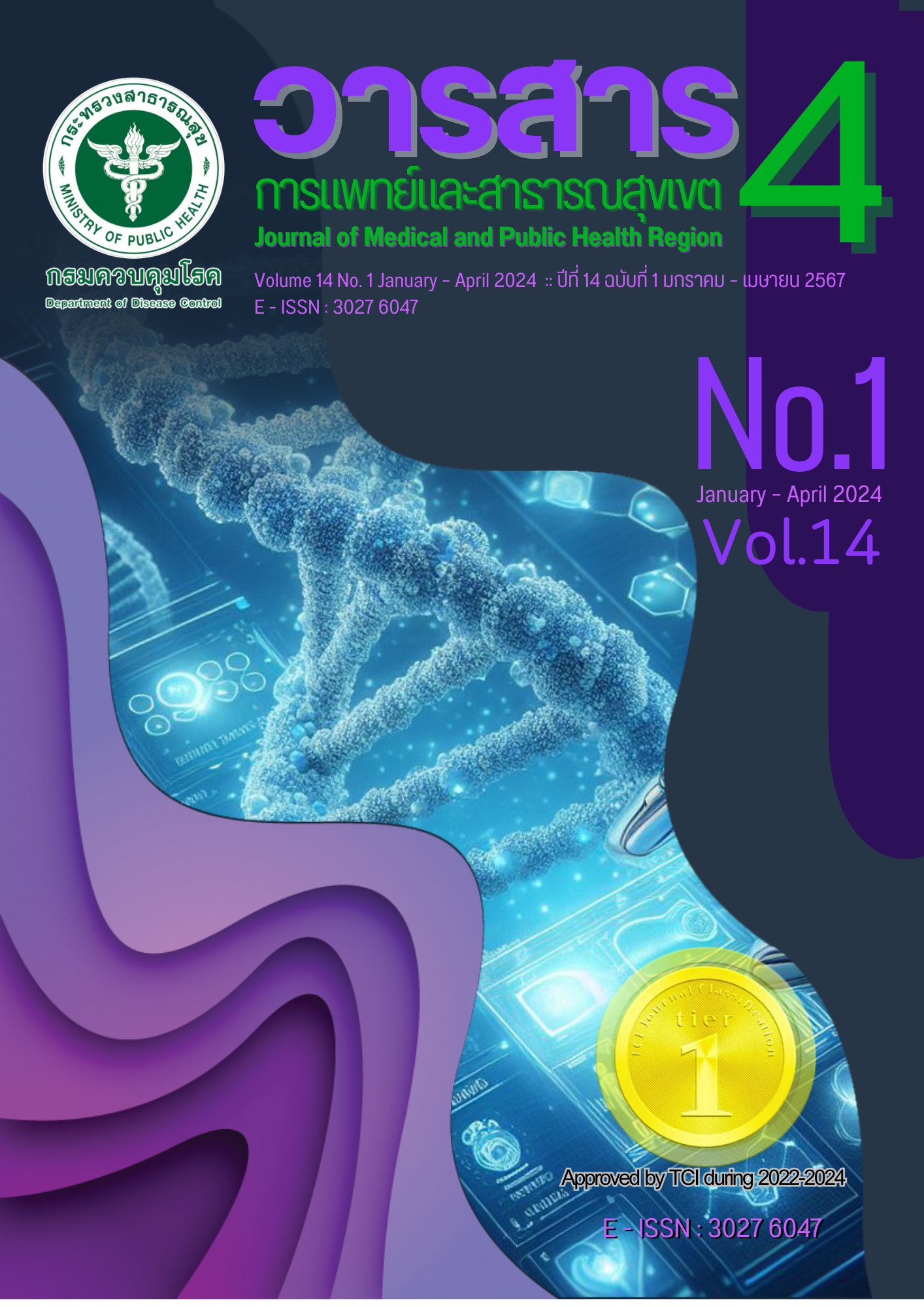ประเมินระบบรายงานข้อมูลบริการเลิกบุหรี่แบบครบวงจร (โปรแกรมคลินิกฟ้าใส V. 2)
Main Article Content
บทคัดย่อ
ระบบรายงานข้อมูลบริการเลิกบุหรี่แบบครบวงจร (โปรแกรมคลินิกฟ้าใส V.2) ถูกสร้างขึ้นเพื่อเป็นฐานข้อมูลสำหรับติดตามการบำบัดรักษาผู้สูบบุหรี่ของประเทศไทยแต่ไม่เคยถูกประเมินมาก่อน งานวิจัยนี้เพื่อศึกษากระบวนการ คุณลักษณะเชิงปริมาณ เชิงคุณภาพ และให้ข้อเสนอแนะปรับปรุงโปรแกรมคลินิกฟ้าใส V.2 โดยเก็บข้อมูลด้วยวิธีผสมผสานในโรงพยาบาล 2 แห่ง การวิจัยเชิงปริมาณเลือกสุ่มเวชระเบียนผู้ป่วยที่มารับบริการในคลินิกเลิกบุหรี่หรือคลินิกโรคไม่ติดต่อในปี พ.ศ. 2564 เพื่อประเมินความครอบคลุมการรายงาน ค่าพยากรณ์บวก ความครบถ้วน ความถูกต้อง ความเป็นตัวแทน การวิจัยเชิงคุณภาพ
ทำการสัมภาษณ์เจ้าหน้าที่ที่เกี่ยวข้องกับกระบวนการ การใช้ประโยชน์ การยอมรับ ความยากง่าย ความยืดหยุ่น และความมั่นคง จากการทบทวนเวชระเบียนจำนวน 522 ราย พบว่าค่าความครอบคลุมร้อยละ 20.3 ค่าพยากรณ์บวกร้อยละ 61.98 ตัวแปรเพศ และวันที่มารับบริการมีความครบถ้วนทั้งหมดแต่มีความถูกต้องร้อยละ 98.25 และ 61.99 ตามลำดับ ตัวแปรอายุมีค่าความถูกต้องทั้งหมดแต่มีความครบถ้วนร้อยละ 1.17 การรักษาที่ได้รับและผลการรักษาที่บันทึกในโปรแกรมคลินิกฟ้าใส V.2 มีความแตกต่างกับในเวชระเบียนมากจึงมีข้อจำกัดในการเป็นตัวแทน ผู้ที่เกี่ยวข้องทุกระดับมีความเห็นตรงกันว่า การใช้โปรแกรมคลินิกฟ้าใส V. 2 มีประโยชน์ในการบันทึกข้อมูลสำหรับติดตามการรักษาการเลิกยาสูบแต่ยังไม่มีการใช้ประโยชน์ดังกล่าวจริงรวมถึงไม่มีการใช้ในการกำหนดนโยบาย การเข้าใช้โปรแกรมและบันทึกข้อมูลไม่เสถียร ไม่สามารถแก้ไขข้อมูล และมีความซ้ำซ้อน ส่งผลให้ความครอบคลุมต่ำ จึงควรพัฒนาโปรแกรมให้เสถียรและเชื่อมโยงฐานข้อมูลฟ้าใส V.2 กับฐานข้อมูลโรงพยาบาล เพื่อเพิ่มคุณภาพข้อมูลและลดความซ้ำซ้อนของงาน เพิ่มเจ้าหน้าที่ทำงานด้านบุหรี่โดยเฉพาะ และประเมินโปรแกรมอย่างสม่ำเสมอโดยเฉพาะหลังปรับปรุงโปรแกรมแล้ว
Article Details

This work is licensed under a Creative Commons Attribution-NonCommercial-NoDerivatives 4.0 International License.
References
World Health Organization. Tobacco. [Internet]. [cited 2022 May 16]. Available from: https://www.who.int/ news-room/fact-sheets/detail/tobacco
Sittibusaya C, Gunvihok T, Yoosabai C, Darasuwon P, Yangsup K, Sonsuphap R. An evaluation of implementation of the national strategic plan for tobacco control No.2 (NSPFTC NO.2) year 2016-2019. International Journal of Current Research 2021; 13(5): 17489-94.
Office of the Tobacco Product Control Board (TH). Report on the performance of the expanded national tobacco control strategic plan 2020-2021; 2022 (in Thai)
Ministry of Public Health (TH). Health data center. [Internet]. [cited 2022 Dec 31]. Available from: https://hdcservice.moph.go.th/hdc/reports/report.php?cat_id=06b9ffbd9fa83f29fef3a7e7ba8119d6&id=a2d0adf54bcd44b1f18931a7b544ad93
Office of the Tobacco Product Control Committee (TH). Tobacco control action plan 2022-2027. Bangkok. Aksorn graphic and design publishing limited; 2022 (in Thai)
Sirimassakul K, Plapol T, Romyen W. Office of Tobacco Products Control Committee Department of Disease Control. Guidelines for smoking cessation for Healthcare Setting. Nonthaburi: Department of Disease Control (TH); 2021: 15-25. (in Thai)
Office of the Tobacco Product Control Committee (TH). Annual report 2021.Bangkok. Aksorn graphic and design publishing limited; 2022 (in Thai)
Buason R. Integrated approaches for research and evaluation 2nd ed. Bangkok: Chulalongkorn University Press; 2012 (in Thai)
Creswell JW. Research design: qualitative, quantitative, and mixed methods approaches. 4th ed. Thousand Oaks, CA: Sage Publication; 2014
German RR, Lee LM, Horan JM, Milstein RL, Pertowski CA, Waller MN; Guidelines Working Group Centers for Disease Control and Prevention (CDC). Updated guidelines for evaluating public health surveillance systems: recommendations from the Guidelines Working Group. MMWR Recomm Rep [Internet]. 2001 [cited 2022 Dec 31]; 50(RR-13): 1-35. Available from: https://www.cdc.gov/mmwr/preview/ mmwrhtml/rr5013a1.htm
Ngamjarus C, Chongsuvivatwong V, McNeil E. n4Studies: sample size calculation for an epidemiological study on a smart device. Siriraj Medical Journal 2016; 68(3): 160-70.
Daniel WW. Biostatistics: a foundation of analysis in the health sciences. 6th ed. New York: John Wiley & Sons; 1995.
Siriwat C, Saengthong P. Measles surveillance system evaluation in Chattrakarn Hospital,Phitsanulok provine,Thailand January 1, 2013 – February 29, 2016. Journal of Disease Prevention and Control: DPC.2 Phitsanulok 2017; 4(2): 49-63. (in Thai)
Mongkonsin C, Klangburum W. Evaluation of melioidosis surveillance system in mahasarakham province in 2019. Journal of the Office of DPC7 Khon Kaen 2019; 26(3): 59-71. (in Thai)
Sripol R. Evaluation of dengue virus infection,leptospirosis and gonorrher surveillance in Pha Khao Hospital, Pha Khao district, Loei provine 2015. Journal of the Office of DPC7 Khon Kaen 2017; 24(1): 80-90. (in Thai)
Sakawduen N, Thamvong A. Dengue surveillance evaluation at Wangnuea Hospital, Lampang province, Thailand during 2018-2020. Weekly Epidemiological Surveillance Report, Thailand 2022; 53(30): 453-61. (in Thai)
Wongsanuphat S, Sangwanloy S, Sopha P, Buangsuang W, Denduang S, Thongplean A, et al. Enhancing coronavirus disease (COVID-19) surveillance system through information technology, Thailand, 2020. OSIR [Internet]. [cited 2021 Sep 19]; 13(3): 90-100. Available from: http://www.osirjournal. net/index.php/osir/article/view/214
Halliday LE, Peek MJ, Ellwood DA, Homer C, Knight M, McLintock C, et al. The australasian maternity outcomes surveillance system: an evaluation of stakeholder engagement, usefulness, simplicity, acceptability, data quality and stability. Aust N Z J Obstet Gynaecol 2013; 53(2): 152-7.

